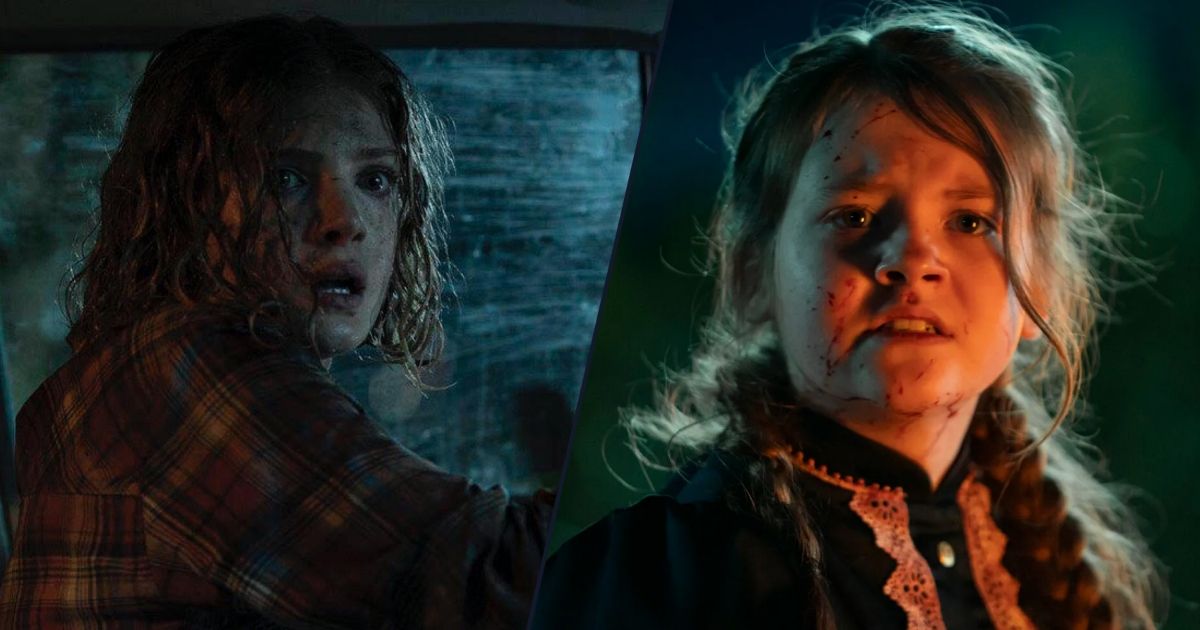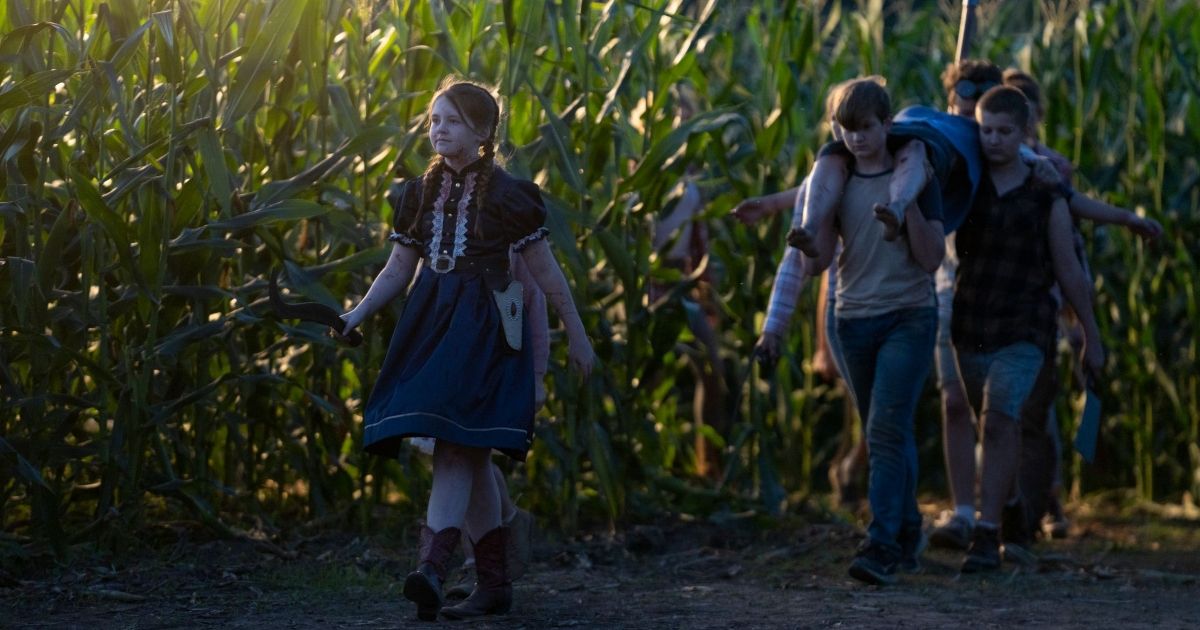The new Children of the Corn certainly follows the rudimentary template of the story — a creepy cult of kids in a corn field killing adults — but it veers from Stephen King’s original and the many cinematic adaptations in some surprising ways. First, it’s a quasi-sequel, taking place when all the adults are alive and before the small Nebraskan town descends into a supernatural Lord of the Flies type situation.
Second, and more importantly, it mines rich metaphorical content from the material in a way which hasn’t been done in previous adaptations of the story or, for that matter, most King tales. Writer/director Kurt Wimmer imbues this iteration of Children of the Corn with relevant and urgent sociopolitical themes without overwhelming the text with subtext, akin to what he did with his scripts for Law Abiding Citizen and Equilibrium. Wimmer and stars Elena Kampouris and Kate Moyer spoke to MovieWeb about the film and its themes.
COVID of the Corn
Children of the Corn follows an uprising of murderous children in a small Nebraskan town led by one young girl, Eve (Moyer), who was adopted and transplanted to the town after a horrifying event. Eve has a kind of psychic connection to the land there, along with a murderous intent driven by her belief in a bloodthirsty god of the corn.
Eve drives the other impoverished kids to rise up against the adults, leaving Boleyn (Kampouris) to try and stop her. It’s a somewhat sparse narrative set in a desolate rural town, which, in a way, made it a great COVID film. Wimmer, his crew, and a lot of safety protocols fueled the production back in 2020.
“It has been a little under three years. We started shooting April 2020. We were the only film shooting on Earth,” said Wimmer, explaining the delay between filming and a wide release. “And so what happened was very simple — it was COVID. People seem to have forgotten already that COVID closed down theaters for the last few years. It wasn’t until Tom Cruise came and saved Hollywood last year that we could even have a conversation with our distributors about when we can release this movie in theaters, because we didn’t want it to just go to streaming for the obvious reasons; we put a lot of work into it […] So that’s why we’re having this conversation now, rather than two and a half years ago.”
“I feel like people don’t really understand just what a miracle having made this film is, because people say, ‘Oh, we shot this during COVID, and it doesn’t mean as much anymore, because everybody’s adapted,” added Kampouris. “But really, it was like the most impossible thing that we were undertaking. People were calling us crazy, people were jumping ship. Nothing was alive at that time, nothing else was going […] The fact that we actually managed to film this, that it’s all done, it’s crazy, and I can’t emphasize enough how difficult this was, and how much of a team effort it was to get this thing seen.”
Kurt Wimmer Mines Corn in Australia
Wimmer and his team, including producer Lucas Foster, were actually sort of brilliant about filming Children of the Corn. “We were in Australia, and Australia was completely shut down,” explained Wimmer. “The government said, ‘Well, we are shutting everything down,’ and we said, ‘But mining isn’t shut down.'” Wimmer elaborated:
Mining is what makes Australia go, and we said we are fundamentally a mining operation. We operate exactly the same as a mining operation, and we will adopt the rules that the mining operations have in Australia in order to keep going. We said, it’s going to be good for you.if you are the first people to say, ‘Listen, we’re going to stand up, we’re gonna fight COVID, not by shutting ourselves away, but by actually figuring out a way to get back to work. And they let us go under those auspices.
The result? Nobody got COVID, and Children of the Corn got made.
The New Children of the Corn Is All Grown Up
While the 1980s version of Children of the Corn is well-liked by many, it’s not often the first Stephen King adaptation people name when considering their favorites. So it’s surprising that there have been 10 film versions of the story leading up to this very different one. Wimmer, Moyer, and Kampouris deliberately avoided studying the past in telling this new variation on King’s tale. “I didn’t see the films, except for the first one, but that wasn’t with me,” said Wimmer. He continued:
It was Stephen King’s short story and the seeds inside that story. I think people keep coming back to it primarily because it has this fundamental idea which is very sticky, which is children taking back the power, that the adults are messing everything up and the kids are saying, “We’re not putting up with that.” That’s a powerful idea. But also the title, there’s something so unconscious under just the title of Children of the Corn. I’ve never spoken to Stephen King in person, but I’ll bet that title popped into his head and he said, “I gotta write something around that.”
“I actually didn’t end up watching any of the old movies, and I hadn’t really heard about it before I got the role and we started working on it,” added Kampouris. “But I feel like that also helps my performance, or other people’s performances. Because we weren’t basing our characters off somebody else. We were kind of taking them into our own hands and working with them to bring our own selves into them.” Kampouris continued:
In approaching this one, since it is like a reimagining and definitely a fresh take, I just went in with a clean slate, but also, we understood the legacy that is behind it and respect that. That’s what I think is interesting about this one, it’s juicy, and it’s got that classic feel to it, but he does something new with it.
Kate Moyer and Kids in Horror
Moyer, who was roughly 11 when she starred as Eve in Children of the Corn, is downright diabolical in the role. Creepy kids have been a horror staple, but it’s not often you see them in such a grisly manner. From pulling out someone’s eyeball to executing a man in front of his daughter, Moyer’s character is a full-blown monster, and she’s great at it. However, that’s a pretty difficult thing to ask of an 11-year-old. Luckily, Wimmer and his crew kept a safe set.
“That was like a frozen time,” explained Moyer poetically. “Because, from the moment I left to the moment that I went home, it was like COVID didn’t even exist. We were kind of just stuck in our own little world, and we were all super close with each other. So, my 11-year-old, 12-year-old self is just like that memory.”
Fortunately, filming a horror movie is much different than watching a horror movie, and with all the reading, preparation, rehearsal, makeup, technical aspects, and discussions, Moyer wasn’t disturbed by the movie like members of the audiences would be. “I did see the full movie, and of course, it’s not as scary to me, because I know what happens,” said Moyer.
Wimmer’s cast of kids comes across as mischievous and menacing, going above and beyond the filmmaker’s expectations. “I was concerned, because I knew that there are some pitfalls when you’re making movies that have a bunch of really young kids in it,” said Wimmer. “Kate, she’s great, but a lot of these kids were not actors […] but these kids really became actors by the time we were done. It was pretty impressive.”
Occupy Corn Street
The titular children in the film become a powerful reflection of younger generations that are angry about the environment, economy, and life that was left to them from older generations. Their radical uprising against the adults who have let the town die feels like a political act, in some ways. It’s a clever idea that Wimmer superimposed over the structure of the original tale.
“The story’s very skeletal,” explained Wimmer. “It’s a short story. There’s not a whole heck of a lot there, but it struck me, this is very elastic. This can be taken and brought over to contemporary struggles between kids and adults today very easily. Because children represent the future, and corn represents the earth very clearly […] Kids are far more aware than ever before. They’re speaking out. They’re really getting bolder, the internet has given them a megaphone, and they’re starting to use it in ways that we’ve never seen before. And I thought, it all makes perfect sense to me.”
The Children (of the Corn) Are Our Future
“You have the socioeconomic angle to it,” added Kampouris, “and what I love that Kurt injected into this is the focus on how we are poisoning ourselves and poisoning our planet. We’ve got to love our planet, and it sounds to me that these kids want to live organically, and not poison what’s feeding us and what we should be taking care of. It’s really disturbing, the herbicides, or pesticides, the GMOs, all the stuff that’s manmade with geoengineering. It just had me meditating on this stuff while shooting.” Kampouris continued:
Seeing the beautiful landscapes of Australia, and then seeing the lands that were burned from all the fires, it really hits you. Thinking, okay, all the bees are dying, how rare it is to see butterflies in the spring and summer than I used to when I was younger, and the birds chirping in the morning that used to wake me up. I feel less of it.
“We know that the Earth is not headed in a good direction,” said Wimmer. “I think everybody can pretty much agree on that. And the only place that you can place the blame is at the threshold of the people running the show, and that’s the adults. These are the ones who are planning the future of this world — and they’re not doing a great job. If I were a kid who’s gonna have to live in that future, I could really get behind taking the reins.”
Children of the Corn, with its grisly rural setting, points to the brutal ways in which this might happen if nothing changes. Produced by Tiger13, Anvil Entertainment, and Digital Riot, Children of the Corn is now available in theaters from RLJE Films.
Stay connected with us on social media platform for instant update click here to join our Twitter, & Facebook
We are now on Telegram. Click here to join our channel (@TechiUpdate) and stay updated with the latest Technology headlines.
For all the latest Education News Click Here


